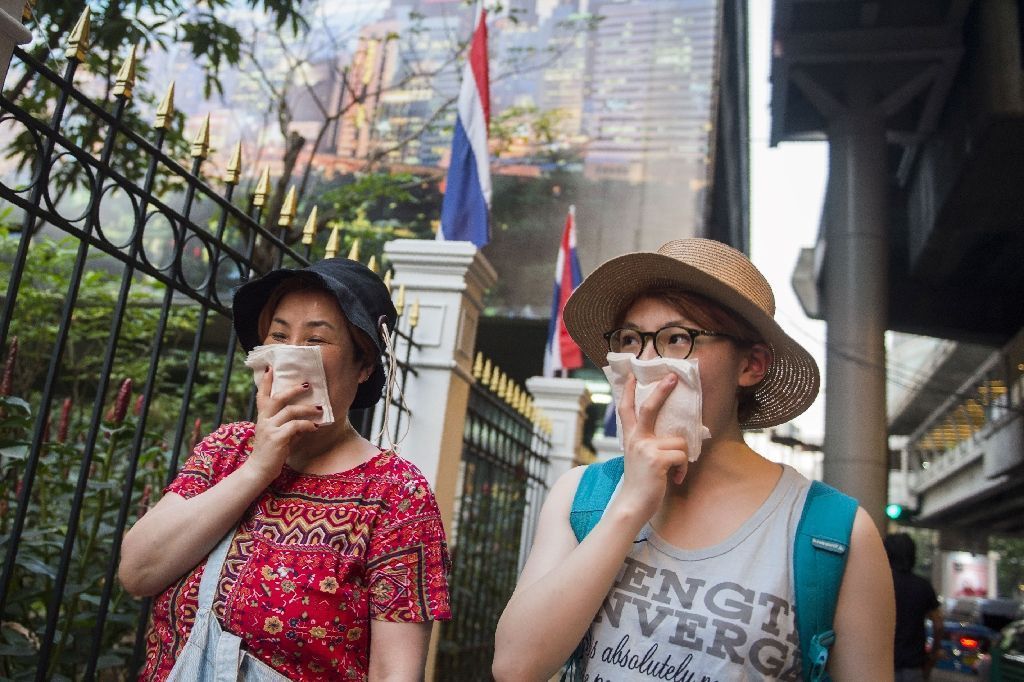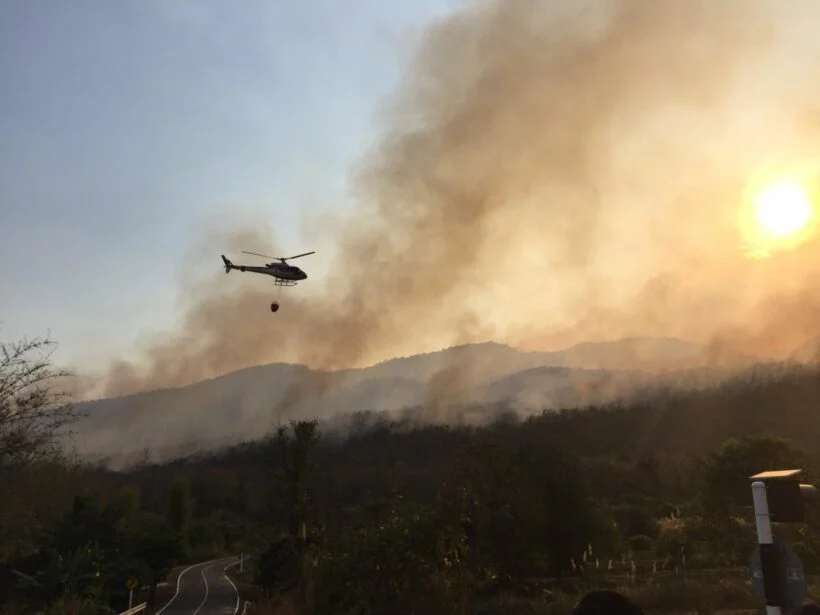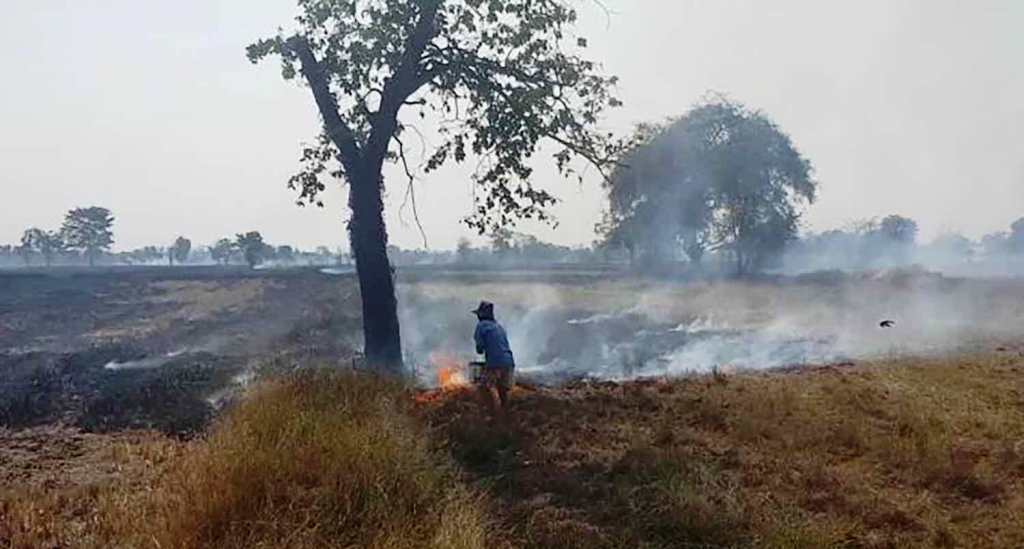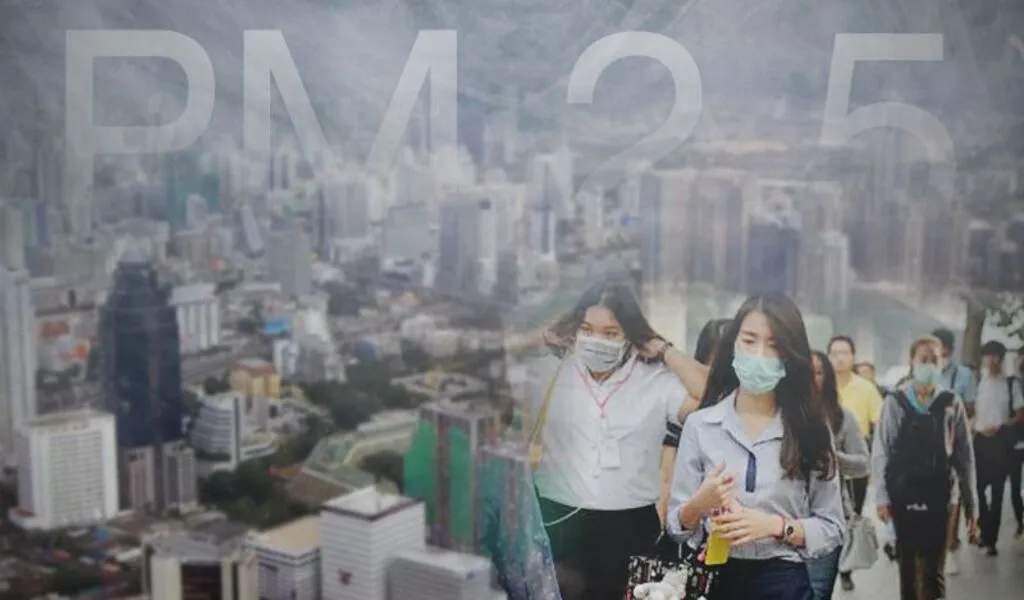News
Thailand’s Air Quality Once Again Under Threat From Toxic PM 2.5 Haze

It’s November and a cool breeze is blowing in northern Thailand. While this should be welcomed as it heralds the cool season, instead it signals that burning season is making a comeback and smoke-laden haze that contains fine particulate matter (PM 2.5) is returning.
Many parts of Thailand are once again under threat from hazardous PM2.5 pollution. Poor air quality conditions induced by hazardous haze have begun to impair the health of people in numerous regions.
According to a recent news source, citizens in 31 provinces, including Samut Sakhon, Nakhon Pathom, Uthai Thani, Suphan Buri, Chai Nat, and Bangkok, are living in a cloud of smoke. The places had far above-average levels of air pollution.
According to the Department of Pollution Control (DPC), 34 districts in Bangkok reported PM 2.5 levels that exceeded the safety guideline.
Experts and regulators predict that haze pollution will be greater this year than previous due to the El Nino phenomenon, which has resulted in severe temperature rises with minimal rainfall and a prolonged dry spell.
The government, organizations, nonprofits and companies have intensified their efforts to curb the detrimental effects of the air pollution caused by the fine dust through stricter measures, innovation, smart tools, sustainable projects and research studies.

Weapons to battle Toxic PM2.5 haze
In response to the warning, the government has been prompted to address the problems of air pollution in order to secure clean air for all.
Speaking at a seminar last month, Sakda Tridech, head of Air Quality and Noise Innovation, a Sub-Division of the PCD, under the Ministry of Natural Resources and Environment said his department has established a network of air quality monitoring which help monitor the presence of pollutants, allowing authorities to take immediate action to improve air quality and protect people’s health.
Now there are 87 air quality monitoring sites, with another 9 stations to be added soon, he said.
“We also have mobile monitoring and assessment units. They are equipped with a range of necessary tools,” he added.
The PCD has also developed innovative weather-forecasting systems which are able to give accurate predictions for next week. The tool can also predict how the particles travel, he added.
“The forecasting systems help us to prepare for the future. We can convey a message to people who may need to take precautionary steps to avoid the pollution,” Sakda said.
The department has worked with the National Science and Technology Development Agency and the Thai Meteorological Department to process the weather data and uses that information to predict weather conditions and give warnings, he added.
To better battle the fine dust that blights the northern provinces where burning intensifies, Sakda noted, the department has launched the “Burn Check”, a mobile app that helps manage burning and mitigate the problems of wildfires, particulate matter and haze.

Monitoring Hotspots in Thailand
According to him, farmers are required to submit a request for burning via the app to authorities for approval before farming residues can be burned. The app provides information on the amount of airborne dust as well as air quality which are used by authorities to consider whether to approve the requests.
The tool allows authorities and villagers to see hotspot data and monitor the fires in real time, he stressed.
To motivate farmers to avoid burning farming waste in their fields, Sakda said the PCD has recently added a new app feature that allows them to sell the crops residues to authorities.
“Stopping the burning of farming waste is a tough task. Forbidden fruit is the sweetest. So, we’ve decided to buy the residues from farmers,” he said, adding that open burning of farm waste is the second main source of air pollution in Bangkok, after vehicle emissions.
In an effort to protect people’s health, Sakda said, the department has lowered the country’s safety standard of PM 2.5 from an average of 50 micrograms per cubic meter to 37.5 micrograms per cubic meter from June 1.
In another move, the Ministry of Industry will implement the Euro 5 emission standard for newly manufactured vehicles, effective from January 1, 2024 to help reduce emissions from road transport, an important factor in improving air quality in the city.
The new regulations are part of the government’s action plan to drive the national agenda “solving the problem of particulate pollution”.
He said the government has worked hard to keep on solving the problems of air pollution particularly particulate pollutants by using pro-active approaches, asking for cooperation from the public, upgrading the protective measures as well as issuing and implementing regulations.
“We have looked into lessons learned for air pollution mitigation policies and measures to make sure that they can solve the problems effectively.” Sakda said.

Adopting sustainable agriculture practice
The “Kon Gla Kuen Tin” (Dare to Return) project, according to Pipaksa Thanethawonkun of Kon Gla Kuen Tin, a social company that provides education on sustainable agriculture practice and farming technology. Its goal is to inspire people to return to the countryside and establish smart farming communities that use sustainable farming methods and smart technologies.
“This will enable them to live a self-sufficient life through farming.” “We believe that our project can improve people’s lives and create a more sustainable future,” he stated.
The project also aims to create a new generation of farmers, he added.
“To us, the new generation is not limited to farmers who are young but rather all people with a sustainability mindset who wish to start a farm using new eco-friendly farming methods. We would like to develop people. Lots of problems including farming, traffic congestion and air pollution are caused by humans.” Pipaksa said.
The traditional farming slash-and-burn technique is blamed for generating haze.

Raising awareness about the impacts of toxic PM2.5 pollutants
Kanadej Thamanoonragsa of FHI 360 noted his organization has worked to spread awareness about climate change, health and the impacts of the pollutants, citing a project in Nepal.
He stated that the group has supported the Nepalese government in improving air quality in Kathmandu Valley. It has constructed a set of artificial lungs made of air filters as part of the research to show people how fine dust impacts their health after long-term exposure. The lungs are on display in front of the Ministry of Public Health. The white filters eventually turn black.
“Some people do not realize that the PM 2.5 they inhale is harmful to their health because it does not cause sudden illness or death.” They have the ability to penetrate the respiratory system and lungs. They can induce sicknesses and difficulties if we breathe them in continuously over time. “We intend to launch a similar project in Thailand,” Kanadej stated.
In Thailand, the organization has worked with Asian Institute of Technology to conduct a research study on the impacts of PM 2.5 on humans and with United Nations Population Fund (UNFPA) to carry out a survey to determine the vulnerability in the Thai public health system and preparedness for climate change. It has teamed up with state agencies to provide policy recommendations and sustainable solutions to the air pollution problems.
Furthermore, the organization has worked hand in hand with its partners and startups to develop innovative tools to tackle vehicle emissions such as an AI-driven smoke detector.
“The smart device is used to detect hazardous smoke released from the vehicles. It helps the traffic police reduce the burden of daily manual tasks.” he said.
This Article was first published in Thai PBS

News
Trudeau’s Gun Grab Could Cost Taxpayers a Whopping $7 Billion

A recent report indicates that since Trudeau’s announcement of his gun buyback program four years ago, almost none of the banned firearms have been surrendered.
The federal government plans to purchase 2,063 firearm models from retailers following the enactment of Bill C-21, which amends various Acts and introduces certain consequential changes related to firearms. It was granted royal assent on December 15 of last year.
This ban immediately criminalized the actions of federally-licensed firearms owners regarding the purchase, sale, transportation, importation, exportation, or use of hundreds of thousands of rifles and shotguns that were previously legal.
The gun ban focused on what it termed ‘assault-style weapons,’ which are, in reality, traditional semi-automatic rifles and shotguns that have enjoyed popularity among hunters and sport shooters for over a century.
In May 2020, the federal government enacted an Order-in-Council that prohibited 1,500 types of “assault-style” firearms and outlined specific components of the newly banned firearms. Property owners must adhere to the law by October 2023.
Trudeau’s Buyback Hasn’t Happened
“In the announcement regarding the ban, the prime minister stated that the government would seize the prohibited firearms, assuring that their lawful owners would be ‘grandfathered’ or compensated fairly.” “That hasn’t happened,” criminologist Gary Mauser told Rebel News.
Mauser projected expenses ranging from $2.6 billion to $6.7 billion. The figure reflects the compensation costs amounting to $756 million, as outlined by the Parliamentary Budget Office (PBO).
“The projected expenses for gathering the illegal firearms are estimated to range from $1.6 billion to $7 billion.” “This range estimate increases to between $2.647 billion and $7 billion when compensation costs to owners are factored in,” Mauser stated.
Figures requested by Conservative MP Shannon Stubbs concerning firearms prohibited due to the May 1, 2020 Order In Council reveal that $72 million has been allocated to the firearm “buyback” program, yet not a single firearm has been confiscated to date.
In a recent revelation, Public Safety Canada disclosed that the federal government allocated a staggering $41,094,556, as prompted by an order paper question from Conservative Senator Don Plett last September, yet yielded no tangible outcomes.
An internal memo from late 2019 revealed that the Liberals projected their politically motivated harassment would incur a cost of $1.8 billion.
Enforcement efforts Questioned
By December 2023, estimates from TheGunBlog.ca indicate that the Liberals and RCMP had incurred or were responsible for approximately $30 million in personnel expenses related to the enforcement efforts. The union representing the police service previously stated that the effort to confiscate firearms is a “misdirected effort” aimed at ensuring public safety.
“This action diverts crucial personnel, resources, and funding from tackling the more pressing and escalating issue of criminal use of illegal firearms,” stated the National Police Federation (NPF).
The Canadian Sporting Arms & Ammunition Association (CSAAA), representing firearms retailers, has stated it will have “zero involvement” in the confiscation of these firearms. Even Canada Post held back from providing assistance due to safety concerns.
The consultant previously assessed that retailers are sitting on almost $1 billion worth of inventory that cannot be sold or returned to suppliers because of the Order-In-Council.
“Despite the ongoing confusion surrounding the ban, after four years, we ought to be able to address one crucial question.” Has the prohibition enhanced safety for Canadians? Mauser asks.
Illegally Obtained Firearms are the Problem
Statistics Canada reports a 10% increase in firearm-related violent crime between 2020 and 2022, rising from 12,614 incidents to 13,937 incidents. In that timeframe, the incidence of firearm-related violent crime increased from 33.7 incidents per 100,000 population in 2021 to 36.7 incidents the subsequent year.
“This marks the highest rate documented since the collection of comparable data began in 2009,” the criminologist explains.
Supplementary DataData indicates that firearm homicides have risen since 2020. “The issue lies not with lawfully-held firearms,” Mauser stated.
Firearms that have been banned under the Order-in-Council continue to be securely stored in the safes of their lawful owners. The individuals underwent a thorough vetting process by the RCMP and are subject to nightly monitoring to ensure there are no infractions that could pose a risk to public safety.
“The firearms involved in homicides were seldom legally owned weapons wielded by their rightful owners,” Mauser continues. The number of offenses linked to organized crime has surged from 4,810 in 2016 to a staggering 13,056 in 2020.
“If those in power … aim to diminish crime and enhance public safety, they ought to implement strategies that effectively focus on offenders and utilize our limited tax resources judiciously to reach these objectives,” he stated.
Related News:
Millennials in Canada Have Turned their Backs on Justin Trudeau
Millennials in Canada Have Turned their Backs on Justin Trudeau
News
Google’s Search Dominance Is Unwinding, But Still Accounting 48% Search Revenue

Google is so closely associated with its key product that its name is a verb that signifies “search.” However, Google’s dominance in that sector is dwindling.
According to eMarketer, Google will lose control of the US search industry for the first time in decades next year.
Google will remain the dominant search player, accounting for 48% of American search advertising revenue. And, remarkably, Google is still increasing its sales in the field, despite being the dominating player in search since the early days of the George W. Bush administration. However, Amazon is growing at a quicker rate.
Google’s Search Dominance Is Unwinding
Amazon will hold over a quarter of US search ad dollars next year, rising to 27% by 2026, while Google will fall even more, according to eMarketer.
The Wall Street Journal was first to report on the forecast.
Lest you think you’ll have to switch to Bing or Yahoo, this isn’t the end of Google or anything really near.
Google is the fourth-most valued public firm in the world. Its market worth is $2.1 trillion, trailing just Apple, Microsoft, and the AI chip darling Nvidia. It also maintains its dominance in other industries, such as display advertisements, where it dominates alongside Facebook’s parent firm Meta, and video ads on YouTube.
To put those “other” firms in context, each is worth more than Delta Air Lines’ total market value. So, yeah, Google is not going anywhere.
Nonetheless, Google faces numerous dangers to its operations, particularly from antitrust regulators.
On Monday, a federal judge in San Francisco ruled that Google must open up its Google Play Store to competitors, dealing a significant blow to the firm in its long-running battle with Fortnite creator Epic Games. Google announced that it would appeal the verdict.
In August, a federal judge ruled that Google has an illegal monopoly on search. That verdict could lead to the dissolution of the company’s search operation. Another antitrust lawsuit filed last month accuses Google of abusing its dominance in the online advertising business.
Meanwhile, European regulators have compelled Google to follow tough new standards, which have resulted in multiple $1 billion-plus fines.

Pixa Bay
Google’s Search Dominance Is Unwinding
On top of that, the marketplace is becoming more difficult on its own.
TikTok, the fastest-growing social network, is expanding into the search market. And Amazon has accomplished something few other digital titans have done to date: it has established a habit.
When you want to buy anything, you usually go to Amazon, not Google. Amazon then buys adverts to push companies’ products to the top of your search results, increasing sales and earning Amazon a greater portion of the revenue. According to eMarketer, it is expected to generate $27.8 billion in search revenue in the United States next year, trailing only Google’s $62.9 billion total.
And then there’s AI, the technology that (supposedly) will change everything.
Why search in stilted language for “kendall jenner why bad bunny breakup” or “police moving violation driver rights no stop sign” when you can just ask OpenAI’s ChatGPT, “What’s going on with Kendall Jenner and Bad Bunny?” in “I need help fighting a moving violation involving a stop sign that wasn’t visible.” Google is working on exactly this technology with its Gemini product, but its success is far from guaranteed, especially with Apple collaborating with OpenAI and other businesses rapidly joining the market.
A Google spokeswoman referred to a blog post from last week in which the company unveiled ads in its AI overviews (the AI-generated text that appears at the top of search results). It’s Google’s way of expressing its ability to profit on a changing marketplace while retaining its business, even as its consumers steadily transition to ask-and-answer AI and away from search.

Google has long used a single catchphrase to defend itself against opponents who claim it is a monopoly abusing its power: competition is only a click away. Until recently, that seemed comically obtuse. Really? We are going to switch to Bing? Or Duck Duck Go? Give me a break.
But today, it feels more like reality.
Google is in no danger of disappearing. However, every highly dominating company faces some type of reckoning over time. GE, a Dow mainstay for more than a century, was broken up last year and is now a shell of its previous dominance. Sears declared bankruptcy in 2022 and is virtually out of business. US Steel, long the foundation of American manufacturing, is attempting to sell itself to a Japanese corporation.
SOURCE | CNN
News
The Supreme Court Turns Down Biden’s Government Appeal in a Texas Emergency Abortion Matter.

(VOR News) – A ruling that prohibits emergency abortions that contravene the Supreme Court law in the state of Texas, which has one of the most stringent abortion restrictions in the country, has been upheld by the Supreme Court of the United States. The United States Supreme Court upheld this decision.
The justices did not provide any specifics regarding the underlying reasons for their decision to uphold an order from a lower court that declared hospitals cannot be legally obligated to administer abortions if doing so would violate the law in the state of Texas.
Institutions are not required to perform abortions, as stipulated in the decree. The common populace did not investigate any opposing viewpoints. The decision was made just weeks before a presidential election that brought abortion to the forefront of the political agenda.
This decision follows the 2022 Supreme Court ruling that ended abortion nationwide.
In response to a request from the administration of Vice President Joe Biden to overturn the lower court’s decision, the justices expressed their disapproval.
The government contends that hospitals are obligated to perform abortions in compliance with federal legislation when the health or life of an expectant patient is in an exceedingly precarious condition.
This is the case in regions where the procedure is prohibited. The difficulty hospitals in Texas and other states are experiencing in determining whether or not routine care could be in violation of stringent state laws that prohibit abortion has resulted in an increase in the number of complaints concerning pregnant women who are experiencing medical distress being turned away from emergency rooms.
The administration cited the Supreme Court’s ruling in a case that bore a striking resemblance to the one that was presented to it in Idaho at the beginning of the year. The justices took a limited decision in that case to allow the continuation of emergency abortions without interruption while a lawsuit was still being heard.
In contrast, Texas has been a vocal proponent of the injunction’s continued enforcement. Texas has argued that its circumstances are distinct from those of Idaho, as the state does have an exemption for situations that pose a significant hazard to the health of an expectant patient.
According to the state, the discrepancy is the result of this exemption. The state of Idaho had a provision that safeguarded a woman’s life when the issue was first broached; however, it did not include protection for her health.
Certified medical practitioners are not obligated to wait until a woman’s life is in imminent peril before they are legally permitted to perform an abortion, as determined by the state supreme court.
The state of Texas highlighted this to the Supreme Court.
Nevertheless, medical professionals have criticized the Texas statute as being perilously ambiguous, and a medical board has declined to provide a list of all the disorders that are eligible for an exception. Furthermore, the statute has been criticized for its hazardous ambiguity.
For an extended period, termination of pregnancies has been a standard procedure in medical treatment for individuals who have been experiencing significant issues. It is implemented in this manner to prevent catastrophic outcomes, such as sepsis, organ failure, and other severe scenarios.
Nevertheless, medical professionals and hospitals in Texas and other states with strict abortion laws have noted that it is uncertain whether or not these terminations could be in violation of abortion prohibitions that include the possibility of a prison sentence. This is the case in regions where abortion prohibitions are exceedingly restrictive.
Following the Supreme Court’s decision to overturn Roe v. Wade, which resulted in restrictions on the rights of women to have abortions in several Republican-ruled states, the Texas case was revisited in 2022.
As per the orders that were disclosed by the administration of Vice President Joe Biden, hospitals are still required to provide abortions in cases that are classified as dire emergency.
As stipulated in a piece of health care legislation, the majority of hospitals are obligated to provide medical assistance to patients who are experiencing medical distress. This is in accordance with the law.
The state of Texas maintained that hospitals should not be obligated to provide abortions throughout the litigation, as doing so would violate the state’s constitutional prohibition on abortions. In its January judgment, the 5th United States Circuit Court of Appeals concurred with the state and acknowledged that the administration had exceeded its authority.
SOURCE: AP
SEE ALSO:
Could Last-Minute Surprises Derail Kamala Harris’ Campaign? “Nostradamus” Explains the US Poll.
-

 News3 years ago
News3 years agoLet’s Know About Ultra High Net Worth Individual
-
Entertainment2 years ago
Mabelle Prior: The Voice of Hope, Resilience, and Diversity Inspiring Generations
-

 Health3 years ago
Health3 years agoHow Much Ivermectin Should You Take?
-

 Tech2 years ago
Tech2 years agoTop Forex Brokers of 2023: Reviews and Analysis for Successful Trading
-

 Lifestyles3 years ago
Lifestyles3 years agoAries Soulmate Signs
-

 Movies2 years ago
Movies2 years agoWhat Should I Do If Disney Plus Keeps Logging Me Out of TV?
-

 Health3 years ago
Health3 years agoCan I Buy Ivermectin Without A Prescription in the USA?
-

 Learning2 years ago
Learning2 years agoVirtual Numbers: What Are They For?












